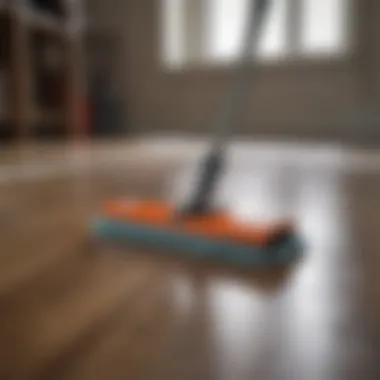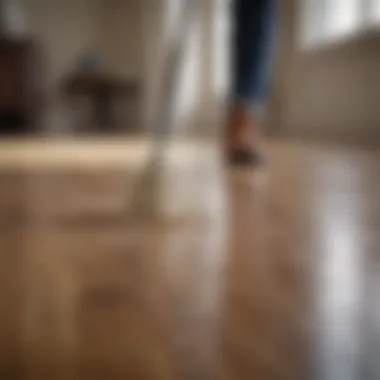Effective Strategies for Dust-Free Hardwood Floors


Intro
Dust on hardwood floors presents a common, though often overlooked, challenge for homeowners. This issue extends beyond mere aesthetics; it impacts indoor air quality and overall cleanliness. To assist homeowners in tackling this persistent problem, it is essential to employ effective strategies that not only remove dust but also preserve the integrity of the flooring.
In the sections that follow, we will discuss a variety of tools, techniques, and maintenance practices designed to achieve dust-free hardwood surfaces. By exploring various methods, homeowners can select the best strategies suited to their specific needs, thus fostering a cleaner and more inviting living environment.
Understanding Dust on Hardwood Floors
Dust accumulation on hardwood floors is not merely an aesthetic issue, but also a practical concern. Understanding its characteristics and sources assists homeowners in developing effective cleaning strategies. A proper comprehension of dust can lead to healthier living environments. Dust can harbor allergens and irritants, impacting air quality and the comfort of those within the space.
Nature of Dust in Homes
Dust in homes is a conglomerate of various particles. These particles include skin cells, pet dander, pollen, and small fibers from clothing and textiles. Dust accumulation is inevitable, especially in living areas where people congregate often. Understanding the composition of dust can help inform cleaning methods. For example, certain dust particles can cling to surfaces more tightly than others.
Moreover, hardwood floors, being smooth and often polished, can show dust more evidently compared to other types of flooring. This visibility can encourage timely cleaning and maintenance, which preserves the beauty of the wood.
Common Sources of Dust
Identifying the sources of dust is vital for effective removal. Dust can enter the home through various channels. Here are common contributors to dust accumulation:
- Open Windows and Doors: Outdoor dust and pollen easily enter homes when windows and doors are open.
- Foot Traffic: People and pets carry dust inside on shoes and fur, exacerbating the problem.
- HVAC Systems: Air conditioning and heating systems can distribute dust throughout the home if filters are not regularly maintained.
- Household Activities: Regular activities such as cooking, cleaning, and moving furniture can stir up dust, causing it to settle on floors.
Addressing these sources effectively not only helps in keeping hardwood floors clean but also contributes to a healthier indoor environment.
Initial Assessment of Your Hardwood Floors
The initial assessment of your hardwood floors is a critical step in creating an effective dust removal strategy. Understanding the current state of your flooring enables you to tailor your cleaning approach, which ensures optimal maintenance. This section emphasizes the importance of knowing where the dust collects and how the floor's condition influences cleaning methods. Regular assessment can help identify issues before they escalate, preserving your floor's aesthetic and longevity.
Identifying Dust Accumulation Areas
To start, it is essential to pinpoint where dust accumulates most on your hardwood floors. Observing these areas regularly can guide your cleaning efforts. Some common dust hotspots include:
- Under furniture: Tables and couches often hide dust underneath them.
- High-traffic zones: Pathways near doors and hallways can gather dust quickly due to foot traffic.
- Corners and edges: Dust tends to gather in corners where airflow is limited.
- Around vents and windows: Areas near heating or cooling vents can be dust traps.
By recognizing these accumulation areas, you can focus your cleaning routines where they will be most effective. A precise identification of these spots will help in establishing a consistent cleaning schedule that addresses the issue before it becomes overwhelming.
Evaluating Floor Condition
Once you've determined where dust accumulates, the next step is to evaluate the overall condition of your hardwood floors. Several factors come into play during this assessment:
- Surface damage: Scratches or dents can collect dust more easily and may require specific cleaning solutions.
- Finish wear: Understanding whether the finish is intact helps in choosing the right cleaning products. Worn finishes may not tolerate certain cleaners, resulting in damage.
- Moisture levels: Excessive moisture can lead to more dust settling on the surfaces. Check for any areas where spills may have affected the wood.
By evaluating the condition, you take proactive measures in maintaining your hardwood floors. If any issues are found, they can be addressed before you implement cleaning methods.
Regular assessments not only enhance cleanliness but also increase the life span of your hardwood surfaces.
Tools Required for Dust Removal
In the quest for maintaining immaculate hardwood floors, the selection of appropriate tools cannot be overstated. The right tools are crucial for effective dust removal and preserving the quality of the flooring. This section explores essential tools that simplify the cleaning process and enhance the longevity of your hardwood surfaces.
Microfiber Mops
Microfiber mops stand out as indispensable allies in the battle against dust on hardwood floors. Their unique fibers are designed to attract and trap dust particles, making them more effective than traditional mops. This quality ensures that less dust is reintroduced into the air while cleaning.
Using a microfiber mop is straightforward. Lightweight and easy to maneuver, these mops can reach corners and under furniture, where dust often accumulates. Most models allow you to attach a washable pad, making them environmentally friendly and economical over time. Regular use of microfiber mops will significantly reduce dust accumulation, benefiting both the aesthetics of your home and your overall health.
Vacuum Cleaners with Hardwood Attachments


Vacuum cleaners specifically designed for hardwood floors are critical in any cleaning arsenal. These vacuums, often equipped with soft bristle attachments, avoid scratching the surface of the floor while effectively removing dust. They offer powerful suction capabilities, which can remove dust from crevices and hard-to-reach areas.
When selecting a vacuum, consider models that have adjustable suction power. This feature allows you to tailor the cleaning process according to the surface type, ensuring gentle yet effective dust removal. It is also beneficial to choose a vacuum equipped with a HEPA filter, as these filters trap finer dust particles, contributing to improved air quality within your home.
Dusting Cloths and Tools
In addition to mops and vacuums, high-quality dusting cloths and tools are essential for maintaining dust-free hardwood floors. Opt for microfiber dusters which can efficiently pick up dust without pushing it around. Their ability to attract particles reduces the need for excessive cleaning motions that might harm the surface.
Moreover, an extendable duster can assist in cleaning fans and high surfaces, ensuring you are not neglecting any areas that might contribute to dust accumulation. While using dusting cloths, do not forget to follow a regular schedule to keep dust at bay.
Taking the time to invest in the right tools will lay the groundwork for an effective cleaning routine. Efficient dust removal is achievable by utilizing a combination of microfiber mops, appropriate vacuum cleaners, and effective dusting tools.
Daily Cleaning Routines
Daily cleaning routines are essential for maintaining the elegance and cleanliness of hardwood floors. Regular upkeep not only prevents the accumulation of dust but also enhances the durability of the flooring. When a routine is established, it helps to create a consistent standard of cleanliness in the home, significantly impacting the overall aesthetic appeal of hardwood surfaces.
Maintaining a dust-free environment can also have health benefits. Dust can harbor allergens and particulate matter, which may aggravate respiratory issues. For anyone who suffers from allergies or asthma, having a clean living space is crucial.
Employing a well-considered daily cleaning routine will set the foundation for more thorough weekly or monthly deep cleaning methods. Therefore, it is beneficial to integrate simple yet effective methods daily to keep the floors looking pristine.
Effective Sweeping Techniques
The sweeping of hardwood floors should be done with care, as improper techniques may cause scratch damage. Here are some effective sweeping strategies:
- Choose the Right Broom: A soft-bristled broom is preferable as it is less likely to scratch the surface.
- Angle the Broom: Keeping the broom at a slight angle can help trap more dust and dirt in the bristles.
- Use Long, Fluid Strokes: This approach allows for better coverage of the floor surface, minimizing the potential for missed spots.
- Sweep Towards a Center Point: Directing the dust towards one spot makes it easier to collect and removes the need to move dust around the floor multiple times.
Incorporating these techniques into a daily routine can significantly enhance the effectiveness of dust removal efforts, ensuring your hardwood floors remain clean.
Regular Dusting Procedures
To complement sweeping, regular dusting is another vital aspect of maintaining hardwood floors.
- Use Microfiber Cloths: These are effective for trapping dust particles. They can be used to wipe down surfaces near the floors, like baseboards and furniture.
- Dust First, Then Sweep: Dusting helps to dislodge particles from furniture and other surfaces, allowing them to settle on the floor, making sweeping much more efficient.
- Focus on High-Traffic Areas: Dust tends to accumulate more in areas that experience frequent use. Pay special attention to these spots during regular cleaning.
Integrating these dusting practices into daily routines helps sustain a cleaner environment and minimizes the need for extensive cleaning later. By prioritizing daily cleaning activities, homeowners can ensure their hardwood floors retain their beauty and vitality for many years.
Deep Cleaning Methods for Dust Removal
Deep cleaning methods are essential for the effective removal of dust from hardwood floors. Regular cleaning may not address the deeper layers of dirt and dust that can accumulate over time. These deeper cleaning methods serve to maintain the aesthetic and integrity of your flooring. They help in preventing long-term damage and enhancing the lifespan of hardwood surfaces. It is also prudent to consider factors like the type of cleaner used and the techniques employed to avoid harm to the wood finish.
Using Damp Mops
Damp mops are a critical tool in the deep cleaning process of hardwood floors. They can effectively remove dust and dirt while minimizing the use of excess water, which might damage the wood. When using a damp mop, it is crucial to ensure that it is not too wet. A mop that is overly saturated can lead to water damage and warping.
It is advisable to use a quality microfiber mop pad designed specifically for hardwood. This type of mop glides smoothly across the surface, picking up dust and allergens without scratching. Also, regular use of the damp mop in combination with a comprehensive cleaning routine greatly enhances the overall cleanliness of your floors.
Recommended Cleaning Solutions
Choosing the right cleaning solutions plays a vital role in maintaining dust-free hardwood floors. There are various options available, including homemade solutions and commercial products.
Homemade Solutions
Homemade cleaning solutions are a popular choice among many homeowners. One of their key characteristics is their simplicity and the control they offer over the ingredients. Typically made from common household items like vinegar and water or olive oil, these solutions are an eco-friendly and cost-effective alternative.
Benefits: They do not contain harsh chemicals, which makes them safer for kids and pets. Additionally, users can adjust the mixture according to personal preferences. However, it is important to note that certain homemade solutions, like those with vinegar, may not be suitable for all types of finishes. Always test a small area to ensure compatibility with your specific floor type.
Commercial Products
Commercial cleaning products provide convenience and effectiveness. One of their key characteristics is their formulation, specifically designed for deep cleaning hardwood. Many of these products contain surfactants that break down dust and grime without damaging the finish.


Benefits: These solutions can often penetrate deeper layers of dirt and are tested for safety on hardwood floors. However, some commercial products may contain strong chemicals, which can cause concerns for sensitive individuals. It is always advisable to read labels carefully and select products marked as safe for hardwood use.
Maintaining Dust-Free Floors
Maintaining dust-free floors is a critical component of overall home hygiene and aesthetic appeal. Dust not only detracts from the visual quality of hardwood floors but may also cause respiratory issues and aggravate allergies. A cleaner environment enhances the lifespan of your flooring, thus protecting your investment and ensuring a more pleasant living space.
A strategic approach to floor maintenance is required. Below are specific strategies to keep your hardwood floors dust-free, each with their own significance and practical applications.
Establishing a Cleaning Schedule
Creating a cleaning schedule is vital for effective dust management. Regularly planned cleaning prevents dust buildup and keeps your home consistently appealing. Depending on foot traffic, you might want to clean your floors several times a week. Here are some tips for establishing your cleaning routine:
- Daily Spot Cleaning: Quickly address spills or dirt using a microfiber cloth or dust mop. This small step can prevent larger messes.
- Weekly Deep Cleaning: Once a week, dedicate time for thorough cleaning using a vacuum specialized for hardwood floors, followed by damp mopping.
- Monthly Maintenance: Inspect your floors for any signs of wear or damage, and adjust your cleaning schedule if needed. This could include applying a conditioning product to maintain the wood's natural finish.
A consistent approach to cleaning can greatly reduce the amount of dust that settles on your hardwood floors.
Incorporating Area Rugs
Area rugs can serve multiple purposes beyond just decoration. They offer a practical solution in dust management. When placed in high-traffic areas, rugs can trap dust and dirt, reducing the amount that reaches your hardwood floors. Consider the following:
- Material Choice: Opt for low-pile rugs that are easier to clean and do not harbor dust as easily. Natural fibers like cotton can be a great option.
- Easy Maintenance: Ensure that the rugs can be vacuumed or washed regularly to keep them free from dust and allergens.
- Strategic Placement: Position rugs at entryways and in living areas to capture dirt before it can spread throughout your home.
By using area rugs effectively, homeowners can significantly cut down the amount of dust that settles on their hardwood floors.
Managing Humidity Levels
Dust maintenance also involves regulating the humidity levels in your home. Excessive moisture can lead to other issues, such as mold, while very low levels can result in dry wood that is prone to cracking. Aim to keep indoor humidity between 30-50%. Here are ways to manage humidity:
- Use a Dehumidifier or Humidifier: Depending on your local climate, either device may be necessary to maintain optimal humidity.
- Ventilation: Ensure good airflow in your home, especially in areas prone to moisture, like kitchens and bathrooms.
- Monitor Weather Changes: During extreme weather, adjust your humidity control methods accordingly to maintain a stable environment.
Taking control of humidity levels not only benefits your wood floors but also improves overall indoor air quality.
Maintaining dust-free hardwood flooring is not solely about aesthetics; it substantially influences health and well-being.
Employing these methods can lead to a cleaner, healthier, and more inviting home. Implement a thorough cleaning schedule, utilize area rugs, and manage humidity levels to ensure your hardwood floors remain dust-free.
Professional Cleaning Options
Professional cleaning options represent a significant aspect of maintaining hardwood floors. While basic home cleaning techniques such as sweeping and dusting are essential, they often do not capture all the dust and debris that accumulate over time. Engaging professionals can bring several advantages. Among these is the access to specialized tools and products that are more effective than standard household cleaners. Additionally, professionals possess the expertise to tackle issues without causing damage to your hardwood flooring.
When considering the state of your floors, some scenarios would indicate the need for professional assistance. For instance, if your floors exhibit stubborn stains or your cleaning routine does not yield satisfactory results, it may be time to seek expert help. Professionals can also identify underlying problems that a homeowner might overlook, ensuring a thorough deep clean.
When to Consider Professional Help
It is crucial to recognize situations that warrant professional cleaning. One might consider professional help if:
- Persistent Dust and Allergens: If regular cleaning does not remove the dust effectively, professional services can provide deeper cleaning solutions.
- Severe Stains: Stains that have set into the wood may require specialized treatments that only professionals can offer.
- Maintenance of Luster: Over time, hardwood floors may lose their shine. Professionals can apply finishes or treatments that restore their original luster.
- Heavy Foot Traffic: High-traffic areas often accumulate more dust and dirt. Temporary profession cleaning can help in restoring these areas better than routine cleaning.
Ultimately, knowing when to call in experts can save time and ensure that your hardwood floors remain in excellent condition.
Choosing a Reliable Cleaning Service
Selecting a trustworthy cleaning service is crucial to protecting your hardwood floors and ensuring effective cleaning. When searching for a service, consider the following factors:
- Reputation: Look for services that have positive reviews and testimonials. Websites such as Reddit can provide useful insights from real customers.
- Experience: Choose companies that are experienced in cleaning hardwood floors specifically. They should be aware of dos and don’ts that prevent damage to the wood.
- Insurance and Certifications: Verify that the service is insured and has necessary certifications. This protects you against any potential damage during the cleaning process.
- Cleaning Products Used: Inquire about the types of cleaning products employed. Ensure they use eco-friendly and wood-safe chemicals.
By carefully evaluating potential cleaning services, homeowners can secure professional help that meets their specific needs without compromising the quality of their hardwood floors.


Potential Issues During Cleaning
Cleaning hardwood floors requires careful methods to avoid damaging their aesthetic. Homeowners must be aware of potential issues that arise during cleaning processes. The choice of cleaning products and techniques significantly influences both the cleanliness of the floor and its longevity. Addressing these issues ensures that the floors remain not only clean but also visually appealing for years to come.
Avoiding Water Damage
Water is a common enemy of hardwood floors. Excess moisture can seep into seams, leading to warping or buckling. When using wet mops or cloths, it is crucial to keep them damp rather than soaking. Here are some tips to prevent water damage:
- Use a damp mop or cloth: Maintain a balance between cleaning effectively and avoiding excess moisture.
- Quick drying: After mopping, ensure to dry the floor using a clean, dry cloth to remove any lingering moisture.
- Limit spills: Address spills immediately before they can seep into the wood.
Being cautious about water usage preserves the integrity of the hardwood, which is essential for maintaining its durability and appearance.
Preventing Scratch Damage
Scratches can mar the beauty of hardwood floors, and they often arise from improper cleaning practices or the wrong tools. To avoid this type of damage, consider the following strategies:
- Choose appropriate cleaning tools: Always opt for soft-bristled brooms or microfiber mops, as they minimize the risk of scratching.
- Avoid aggressive cleaning pads: Pads that are too abrasive can scuff and scratch the surface.
- Regular inspection of furniture: Ensure that furniture legs are equipped with protective pads to prevent scratches when moving.
~~>By following these suggestions, you can ensure that the beauty of your hardwood floors remains intact, further enhancing the visual appeal of your home.~~
In sum, understanding the potential issues during cleaning, especially regarding water and scratch damage, helps homeowners take informed steps. This attention to detail is essential for sustaining the value and allure of hardwood floors.
Understanding Maintenance Products
Understanding the maintenance products available for hardwood floors is essential in the quest for cleanliness and preservation. Various products aid in keeping these floors not only looking good but also in extending their lifespan. The right maintenance is especially important because hardwood floors are a significant investment in home aesthetics and value.
Using inappropriate cleaning solutions can lead to irreversible damage. Many conventional cleaners contain harsh chemicals suitable for other surfaces but not for wood. Therefore, familiarity with these products is crucial. Additionally, employing the proper maintenance products benefits the floor's appearance, enhancing its sheen and vibrancy.
For homeowners, it is important to consider factors like the existing finish, foot traffic level, and specific needs of the wood type when selecting maintenance products. This personalized approach ensures the selected products enhance the qualities of the hardwood instead of diminishing them.
Types of Floor Cleaners
When it comes to cleaning hardwood floors, there are various types of floor cleaners available. Each type has its features and is suitable for different cleaning conditions.
- Liquid Cleaners: These are common for general cleaning. They are often biodegradable and safe for wooden surfaces. Brands like Bona and Method offer options designed for using on hardwood.
- Pre-Mixed Solutions: These come ready to use and require no diluting. They can be convenient but may contain ingredients that aren't suitable for all types of wood finishes.
- Homemade Cleaners: Some homeowners prefer creating their own cleaning solutions using vinegar and water. However, caution should be applied, as vinegar can dull certain finishes and cause damage with repeated use.
- Cleaning Wipes: For quick cleanups and routine maintenance, cleaning wipes can be an option. They should be specifically urban designated for hardwood to prevent residue.
Benefits of Floor Conditioning Products
Floor conditioning products are vital in maintaining the quality of hardwood surfaces. Unlike regular cleaners, these products nourish the wood, ensuring its longevity. Some key benefits include:
- Enhanced Appearance: Conditioning products often bring back luster to dull hardwoods, resulting in a refreshed look.
- Protection: They often create a barrier against dirt and grime, which can accumulate over time, thus making regular cleaning easier.
- Moisture Regulation: Good floor conditioners can help maintain the natural moisture balance of hardwood, preventing cracks or warping.
- Ease of Application: Most conditioning products are straightforward to apply. Many brands offer spray-on solutions that can be used with minimal effort.
Proper maintenance using the right cleansers and conditioning products is not just cleaning; it's an investment in your home’s value and aesthetic appeal.
In summary, understanding maintenance products, including floor cleaners and conditioning options, is paramount for every homeowner who values the health and appearance of their hardwood floors. Engaging with the right products will ensure you achieve and maintain a dust-free, beautiful home environment.
The End
In this article, we explored comprehensive strategies for effectively removing dust from hardwood floors. Maintaining these floors in a clean state not only enhances the aesthetic appeal of living spaces but also contributes to a healthier indoor environment. Accumulated dust on hardwood can harbor allergens and other irritants, so addressing this issue is vital.
Recap of Best Practices for Dust Management
To keep hardwood floors dust-free, consider the following best practices:
- Establish a Routine: Develop a consistent cleaning schedule to prevent buildup.
- Use Proper Tools: Invest in quality microfiber mops and vacuum cleaners designed for hardwood.
- Regular Maintenance: Perform daily or weekly dusting to minimize dust accumulation.
- Avoid Water Exposure: Ensure cleaning methods do not involve excess water.
- Humidity Control: Maintain optimal humidity levels to prevent dust from settling.
Following these practices ensures that your hardwood floors remain appealing and extend their lifespan.
Final Thoughts on Maintaining Hardwood Floors
Maintaining hardwood floors is an ongoing process. While the dust removal strategies outlined in this article provide a strong foundation, staying mindful of environmental factors can significantly affect cleanliness.
Regularly assess the condition of your floors and the dust levels in your home. Being proactive allows you to adapt your cleaning strategies to address evolving challenges. A commitment to proper floor care leads not just to clean floors, but to a more enjoyable and aesthetically pleasing living environment.
Remember, the state of your floors reflects your overall home care. By embracing proper dust management, you invest in the longevity and beauty of your hardwood surfaces.







